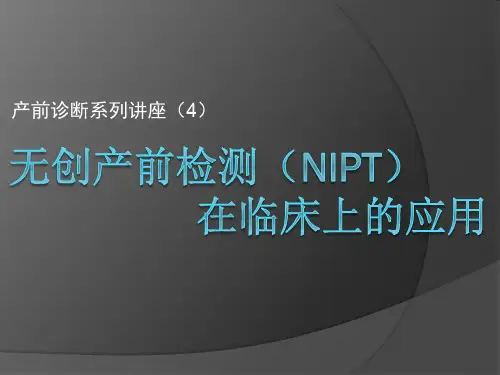NIPT技术发展的历程
2012 2008
2014
大样本临床 实验
各国临床应 用规范
小样本回顾性 和前瞻性研究
T 21 – DD:99.2 %; FPR0.09 % T18 –DD:96.3 %; FPR0.13 % T 13 –DD:91.0 %; FPR 0.13 % 性染色体异常-DD:90.3 – 93.0 % ; FPR 0.14 % to 0.23 %
1000 基因组拷贝/mL血浆 95% 母体+5% 胚胎 50 胚胎基因组 950 母体基因组
母体 21Chr : 1900 二倍体 21Chr : 2000 二倍体 21三体 21Chr : 100 21Chr : 150 三体 21Chr : 2050
区分2000 vs 2050?
NIPT——prove of the principle
Chromosomal aneuploidy is the major reason why couples opt for prenatal diagnosis. Current methods for definitive diagnosis rely on invasive procedures, such as chorionic villus sampling and amniocentesis, and are associated with a risk of fetal miscarriage. Fetal DNA has been found in maternal plasma but exists as a minor fraction among a high background of maternal DNA. Hence, quantitative perturbations caused by an aneuploid chromosome in the fetal genome to the overall representation of sequences from that chromosome in maternal plasma would be small. Even with highly precise single molecule counting methods such as digital PCR, a large number of DNA molecules and hence maternal plasma volume would need to be analyzed to achieve the necessary analytical precision. Here we reasoned that instead of using approaches that target specific gene loci, the use of a locus-independent method would greatly increase the number of target molecules from the aneuploid chromosome that could be analyzed within the same fixed volume of plasma. Hence, we used massively parallel genomic sequencing to quantify maternal plasma DNA sequences for the noninvasive prenatal detection of fetal trisomy 21. Twenty-eight first and second trimester maternal plasma samples were tested. All 14 trisomy 21 fetuses and 14 euploid fetuses were correctly identified. Massively parallel plasma DNA sequencing represents a new approach that is potentially applicable to all pregnancies for the noninvasive prenatal diagnosis of fetal chromosomal aneuploidies.










